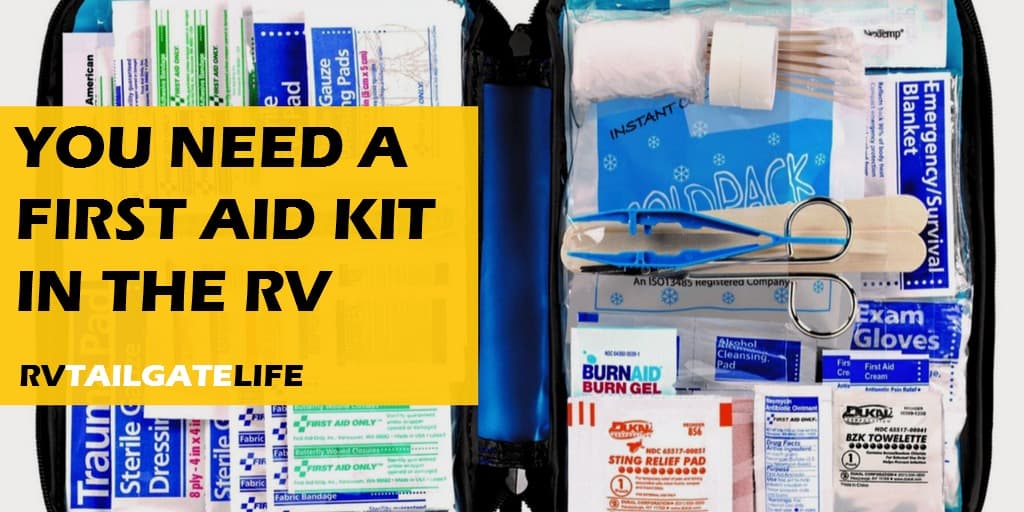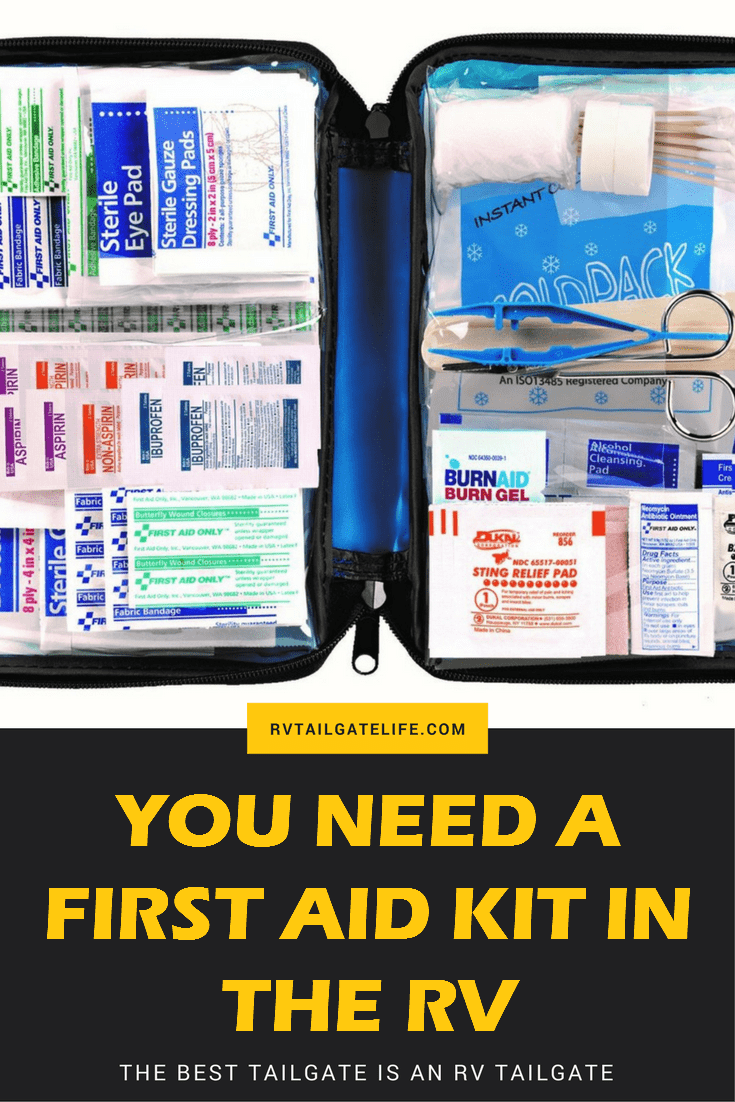Yes, You Need a First Aid Kit in the RV
It does not matter if you are a weekend tailgater or a full-time RVer, you need a first aid kit in the RV!
You probably have a first aid kit at your bricks and sticks home, so why not your home away from home?
One of the benefits of tailgating is that typically emergency personnel aren’t too far away. Most tailgates are on a college campus or near stadiums, with lots of first responders. But don’t rely on these awesome people, because traffic and crowds can slow their response time down.
And many of your first aid needs won’t require emergency personnel. Instead, you can fix scrapes and other minor items on your own and keep the tailgate going. But remember, safety first! Don’t hesitate to send someone to urgent care or the hospital if the situation warrants. You can clean up wounds but if the bleeding doesn’t stop, seek professional help.

Disclosure: This post contains affiliate links for various first aid products below. You get the same low prices and we earn a small commission to help us buy more RV tailgating gadgets. Or game tickets if you go on a shopping spree. Please go on a shopping spree!
What your RV First Aid Kit Needs
We found that the easiest way to start is to buy one of the pre-packaged first aid kits and supplement if necessary. You can find these of various sizes and purposes on Amazon. 121 piece, 299 piece, and 326 piece kits are readily available. You can even get a fully stocked trauma kit similar to what first responders use.
At a minimum, your RV first aid kit should contain the following items:
- First Aid Instruction Booklet
- Bandaids: variety of sizes, purposes
- Moleskin for blisters
- Wound closure strips
- Tweezers
- Scissors
- Safety pins
- Sterile gloves
- Antiseptic towelettes
- Alcohol Prep Pads
- Sterile Gauze (roll and pads)
- Adhesive Bandages
- Dressing
- Medical tape
- Sting relief pads
- Antibiotic ointment
- Burn cream
- Aloe Vera gel
- Calamine lotion
- Antacids
- Pepto Bismol or other anti-diarrhea
- Aspirin
- Tylenol
- Instant cold compress
- Eye pads
- Eye wash
- Thermometer
Finally, it is good to specifically point out one last item: a small roll of duct tape. While you will not want to put this directly on the skin, duct tape can be awesome to help secure a leg splint or large towels needed to stop bleeding. Duct tape is also useful to help keep pressure on wounds.
Special Items for Your Family
You’ll also want to add things for your family’s and friends’ specific needs. You will also want to keep on hand any prescription medicines that you and your family take. And if anyone is highly allergic to any foods or bee stings, you’ll want to keep an Epi-pen on hand.
Is anyone susceptible to migraines? If so, add in some Excedrin Migraine.
Remember also that children have very specific medicines that they can and cannot take. So keep child appropriate medicines available if you have children.
Preventative Items to Keep On Hand
In addition to the first aid kit, we recommend that you keep some preventative items on hand. Things like sunscreen and insect repellent should be readily available in the RV. Chapstick with SPF is also a great thing to keep on hand to prevent chapped lips.
Hand sanitizer and soap should be available at each sink. You want to make it easy for people to clean up, wash away bacteria, and keep nasty germs from spreading.
While not necessarily preventative, we also recommend keeping some cough drops on hand during the fall/winter months. Even if they are just for sore throats following a crazy football game, these sure come in handy.
Regularly Update Your Kit
It is important that you regularly check and update your first-aid kit.
First, many medicines and other supplies will eventually expire. You’ll need to replace these items. It is good to completely review your first aid kit every year to make sure that everything is up-to-date.
Second, as you use things like band-aids, you need to replace them. It is easy to forget about them during the football season. Or if someone uses the first aid kit and doesn’t let you know. So check to make sure that you have enough supplies for your entire first-aid kit.
Third, you need to update your kit as your needs change. The longer you tailgate, the more you will figure out exactly which items you need in your kit. Or as your kids get older, you’ll need different size bandages. As you add members to your tailgate, you may also want to keep more supplies on hand. More people = more first aid incidents. Review your kit regularly to make sure that you have what you need for your family.
Specialized Items for First Aid Kits in the RV
The Red Cross recommends that people keep blankets, radios, and flashlights in their first aid kits. Since we are RVers, we are going to assume that you have many of these items at the ready and with you.
However, you may want to invest in a space blanket or emergency blanket. For starters, these have special reflection and radiation qualities to help you retain body heat in an emergency. Since they fold up so small, they are also great to have in a small first aid kit that you can carry with you on hikes, when a larger blanket is not feasible.
A personal water filter is also great for those RVers that like to go out boondocking or hiking for long periods of time. These remove most bacteria and parasites, making water much safer to drink without using chemicals.
Speaking of water, one of the common ailments that will hit tailgaters is dehydration. Whether because you are out in the sun during a hot tailgate or you over imbibe with adult beverages, dehydration is an issue. Rehydration salts should be considered for your first aid kit in the RV. Mix these with water and drink to help with dehydration or even hangovers.
Don’t forget about your RV pets! Dogs and cats have first aid needs as well. It only takes on dog fight or snake bite to take your dog under. Make sure your first aid kit contains items specifically for your pets, including Vet wrap bandages that won’t stick to fur and tick removal tools.
See Also: 10 Tips for Tailgating With Dogs
A Larger Investment
A basic first-aid kit, and the supplemental items you may add, is a relatively small investment for most people. Kits start at about $15 and go up from there depending on size and contents.
If you are willing to put in additional investment into your first aid kit in the RV, we would recommend that you consider a defibrillator. When sudden cardiac arrest happens, the best chance of survival is when a defibrillator is used within five minutes. Remember, most cardiac arrests happen without any prior symptoms or warnings. And it can happen to anyone!
Amazon has a Philips HeartStart Home Defibrillator currently available for $999.99 on Amazon Prime.
 Now, if you can’t afford to invest $1,000 in your first aid kit, we still recommend that you get CPR training. The Red Cross offers CPR and other first aid training in over 550 locations across the United States. The classes in the Atlanta area are $90 or $110, so a very reasonable additional investment. And these skills could come in handy, from the tailgate to the mall to your workplace.
Now, if you can’t afford to invest $1,000 in your first aid kit, we still recommend that you get CPR training. The Red Cross offers CPR and other first aid training in over 550 locations across the United States. The classes in the Atlanta area are $90 or $110, so a very reasonable additional investment. And these skills could come in handy, from the tailgate to the mall to your workplace.
Keep First Aid Kit in the RV to keep the Tailgate Rolling
The Red Cross and others all recommend that you keep a first aid kit readily accessible in your home and each car. With your RV being both a home and a car, we hope you’ll also be keeping a first aid kit in the RV! Make sure to customize the kit to fit your needs!
Do you have any other suggestions for items to add to the first aid kit in the RV? Comment below!
